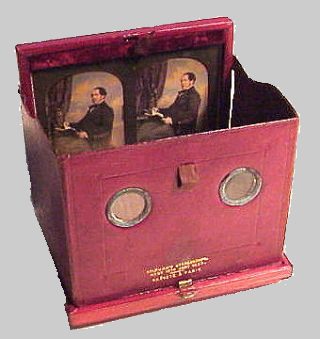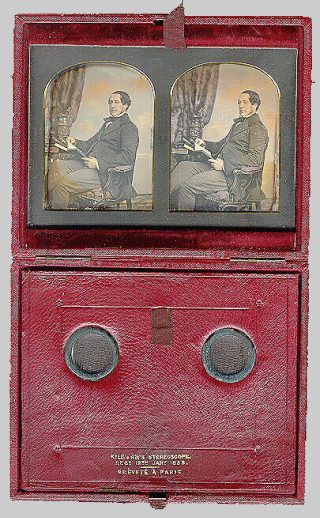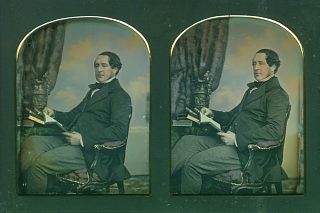

| Daguerrotype |
Louis Jacques Mandé Daguerre first demonstrated his process to the public on September 17, 1839 in Paris. It was the culmination of around 13 years work, some together with Joseph Nicéphore Niépce who had produced some crude images in the 1820s on pewter coated with pale colored bitumen. In 1829, Niépce had found that silver plates could be darkened with iodine vapor, and Daguerre started to work on these, finding they were light sensitive, according to legend by accidentally leaving a spoon on a plate. The real breakthrough came - also possibly by accident, in this case a broken mercury thermometer - when Daguerre found that the images could be made more visible using mercury vapor, which combined with the faint dark silver image to give a more visible gray amalgam.
The problem all experimenters with silver chemistry had faced was that the lighter parts of the subject ended up darker on the image, which was a negative. By careful angling to the light, the unchanged silver plate can be made to look dark while the gray amalgam image appears as the lighter tones of the image. Viewed at the wrong angle, a Daguerreotype looks like a dirty mirror rather than a picture.
The second problem was that of making the images stable to light, solved by soaking the plates in salt solution after their mercury vapor treatment. The images were still very fragile and the silver surface particularly susceptible to darkening by atmospheric pollution. Gold toning, introduced in 1840, soon became universal, and the finished plates were then sealed behind glass in often elaborate cases for protection. Daguerrotypes were always laterally reversed and were thus a 'mirror image' in two senses.
There are many safety hazards in the process, and it should only be attempted under strictly controlled conditions; there are some more modern variants of the process that reduce some of the problems, and occasional workshops are held at some major photographic centers.
Sir Charles Wheatstone published his paper about Binocular Vision only a few months before Daguerre's demonstration of the photographic process, so it was only natural to try to take stereoscopic photographs. This was accomplished by using one camera, which was moved horizontally between taking the two photos. Later, it was becoming increasingly popular to take portraits of people, like the example shown below. For the person being photographed, this meant sitting still for several minutes while the photos were being exposed.
Sometimes, the final photograph was carefully hand-tinted. Companies like Mascher or Kilburn even produced stereo Daguerrotypes in a folding case, which doubled as a stereo viewer.
 |
 |
|
 |
||
| Stereo Daguerrotype, ca. 1853 | ||
 |
|

| Back to the Stereoscopy.com FAQ Page |
